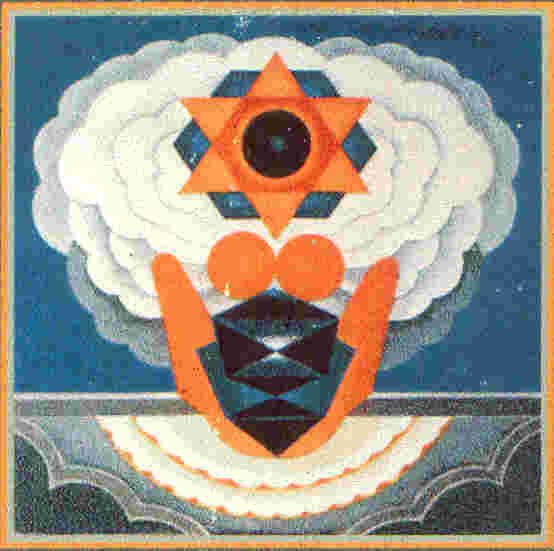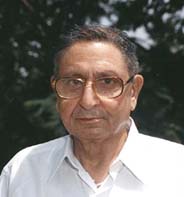|

|

|
|
Kashmiri Pandits' Association, Mumbai, India |

|
| | Home | October-November 2003 Issue | |
|
From the Pages of History
…
J.N. Kachroo Beyond
Symbolism - Our Rituals
Since my childhood, I have been having birthday pooja and
witnessing the same of other members of my family. On birthdays of the
male-members of the family, the 'Kula Guru' would bring from his home an
artistically made 'Raksha', the wrist-band of red thread, with seven
knots. Even now, the audio cassette that substitutes the 'Guru' directs
the 'Jejman' to tie seven knots on the wrist-band. This 'Raksha' is
reverentially placed in a plate on flower petals. Each of the knot is to
be applied a Tilak. While the Tilak is being applied on each by turns, the
'Guru' recites some mantras dedicating them (knots) to Aswathama, Bali,
Vyas, Hanuman, Kripacharya and Parashurama, in that order. They are seven
immortals in the Indian (Hindu) tradition.
These seven knots thus personify the seven immortals whom we
worship on our birthdays. It is commonly believed that prayers are offered
so that the subject of the ritual is granted immortality - a long life -
like the seven immortals. To a modern mind, it is often a Wishful Prayer.
And therefore, non-belief. But if the values each symbolises are borne in
mind even during the 'pooja' period year after year and reminded of on the
birthday, celebrations/pooja one attends or is a witness of, perhaps human
conduct would be more sublime.
The values these immortals symbolise, are to be universal and basic
truths which transcend time and space. The related truths or values to
these immortals are derived from their actions in their 'lives'. They,
ad-seriatim are: 1) Aswathama, the
Consequence of an Unethical Conduct; 2) Bali - Valour and Charity with
grace; 3) Vyas, the Continuity of erudition; 4) Hanuman, Righteous
Conduct, Selfless Devotion and Courage; 5) Vibhisana, his Conviction in
his ideal of righteousness; 6) Kripacharya, his Impartiality in the
discharge of his duty; 7) Parashurama, his Humility, despite his prowess
and might.
There must be some logic in their order. Whatever the logic may be,
let us examine each from a common man's interpretation, implication and
pragmatic application.
Aswathama had acquired mastery over the ultimate weapon. But he
broke all the established ethical norms when he, along with a group of his
companions, entered by stealth the Camp of Pandavas in their absence and
got a number of men killed. He was caught but not killed. His Crown jewel
- a gem - was prised out of his head. He was condemned to live for ever,
the wound never to heal. He attained immortality, but not an enviable one.
His name is a reminder to the mortals, never to resort to an unethical
conduct however powerful he/she may be.
Every one has the potential to own and practise this truth, only if
he/she wills. Hence perhaps, its pre-eminent position in aforesaid
catalogue of values.
Bali knew who Vamana was. Yet he was prepared to surrender all he
had to his lord. King Bali stands for his valour and charity. Everybody
may not be as prosperous as Bali. But one can be graceful while giving
charity whatever one can afford. No show.
It may not be possible for a common man to reach the height of
scholarship and erudition of Vyas. But study of his works and
understanding even a fraction of his wisdom, would be rewarding. His works
belong to human race, irrespective of time and geographical boundaries.
Truly immortal messages! Let the mortals discover them for their own
benefit and elevation.
Hanuman, embodiement of energy and strength should be revered for
his courage, righteous conduct and above all his selfless devotion. He
stands for potential that is inherent in all of us.
Vibhisana's example of fearlessness and courage of conviction make
him immortal. These dispositions are increasingly becoming rare in public
life today. Therefore the chaos.
Kripacharya, takes priority over a more renowned teacher
Dronacharya, the Guru of 'Danudhar Arjun' to immortality. Kripacharya is a
symbol of impartiality. He has no Eklavya episode to shadow his career.
And lastly Parashuram, the master of martial arts, had no temporal
ambition. He lived a hermit's life, though he could be a Samrat, if he had
liked to be. He was one who was never hesitant to admit his mistake. He
publicly apologised to both Ram and Lakshman for his mistake at the time
of Sita's Swayamvar. Parashuram symbolises excellence and strength,
tempered by humility.
Going back to the ritual. After the Janam Divas pooja and
invocations, the 'Raksha', the wrist band with seven knots is tied round
the right hand wrist of the 'birthday boy'. This is supposed to be changed
by a similar one at the next birthday. It has thus to remain a part of the
person throughout his life. To what purpose? Evidently to remind the
wearer of the 'band' constantly that the seven knots personify the seven
immortals who symbolise a string of values. They are supposed to send
cosmic vibrations to the individual to sublimate human behaviour by
practising them.
Let us consider one more practice. A new 'Jenu', the holy thread of
three or six strands is renewed by the eligible on each birthday. He is
expected to wash it everyday and to repeat the sacred 'Gayatri Natra'.
There is no such prescription for the 'Raksha', the wrist band. The mere
view of the seven knots is sufficient to rouse his conscience and act as
governors. It can be effective only if the moral tenets they represent are
conveyed for motor response by the sensory perceptions. Pre-requisite
condition is the awareness of the message these symbols carry.
All these truths/values are symbolised by no less than seven
individuals, each endowed with extraordinary attributes. The Sceptics may
doubt the practicability of observing all of them by an ordinary human in
his/her mundane life. It is believed that the lessons derived from the
examples of Asawathama (Ethical Conduct) and Parshuram (Humality despite
prowess) are all encompassing.
Is it not the right time to interpret the various symbols that our
rituals represent so as to stem the waning faith of the growing
generations exposed to the pulls and pressures generated in the global
village they live in? Would it not enhance love of and loyalty to the
faith and fold? |
|
|
JOIN US |
|
|





